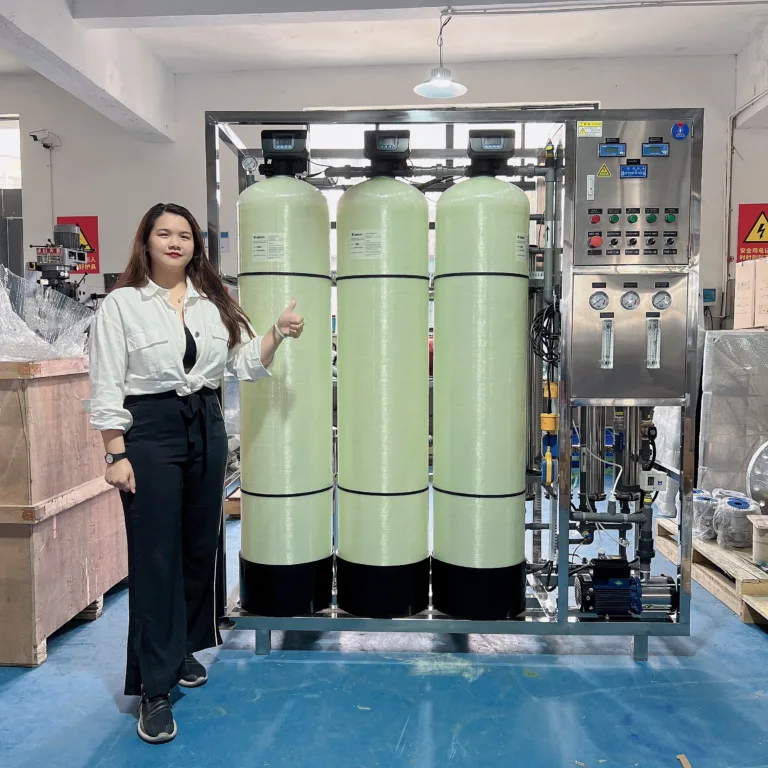1000 LPH RO Water Treatment Solution (≈1 m³/h)
Compact, reliable RO package for brackish/borewell water at small to mid-scale lines.
- Permeate < 100 μS/cm
- 55–70% recovery
- SDI ≤ 3 with UF/MMF
- SS304/316L · PLC/HMI

Who is this for
- Beverage & Food small packaging / ingredient water
- Hotels/Hospitals/Clinics process/service water polishing
- Electronics/Labs rinsing lines
- Borewell/Brackish feed with seasonal turbidity/SDI spikes
Your challenges we solve
- Feed TDS 800–3000 ppm, SDI > 3 → unstable flux & fouling
- Conductivity & flow spikes at shift changes / variable loads
- High CIP frequency due to insufficient pretreatment & scaling risk
Solution architecture
MMF / UF → 5 μm Cartridge → HP Pump (VFD) → RO → Permeate Tank → UV/Ozone (optional)

- UF path keeps SDI ≤ 3 for membrane protection and stable flux.
- Anti-scalant dosing enables higher recovery with controlled scaling.
- PLC/HMI with trends & alarms (pressure, conductivity, flow).
Sizing & selection guide
- Permeate target: < 100 μS/cm @ TDS ≤ 3000 ppm
- Recovery: 55–70% (salinity, temperature, SDI dependent)
- Energy: ≈ 0.7–1.2 kWh/m³ @ 8–16 bar
- Membranes: typical 2 × 4040
- Add UF when: SDI > 3 / colloids/algae risk
Key performance indicators
| KPI | Typical Range | Notes |
|---|---|---|
| Permeate conductivity | < 100 μS/cm | With correct pretreatment & dosing |
| Recovery | 55–70% | Optimized by SDI, temperature, anti-scalant |
| Salt rejection | 95–99% | Element & operating window dependent |
| ΔP fouling trigger | +15–20% vs baseline | Combine with conductivity drift |
| Uptime between CIPs | 3–6 months | Site-specific; UF helps a lot |
| Skid footprint | ≈ 1.6 m² | GA/Layout available |
Options & materials
- SS304 standard, SS316L for chloride exposure
- UV + Ozone final barrier
- CIP skid (acid/alkali/biocide) with interlocks
- Containerized 20/40 ft quick deployment
- Online conductivity, pressure, flow (TOC optional)
Deliverables
- Water balance & recovery sheet
- P&ID & GA/Layout (nozzles, footprint, weight)
- Electrical I/O list & integration notes
- Specs PDF / BOM
- Commissioning checklist & O&M guidance
Case study
Beverage Bottling – LATAM
- Feed: Borewell, TDS 1800–2200 ppm, SDI 6–7
- Solution: MMF + UF + 1000 LPH RO + CIP
- Results: Permeate < 60 μS/cm, Recovery ~65%, > 6 months between CIPs

*Performance depends on site conditions; reference only.
よくあるご質問
Do I need UF pretreatment?
For feeds with SDI > 3, colloids/algae risk or frequent turbidity spikes, UF is recommended to stabilize flux and extend membrane life.
What recovery should I expect at 1000 LPH?
Typical 55–70% for brackish feeds. As a rule of thumb:
• TDS 500–1,500 ppm → 65–70%
• TDS 1,500–3,000 ppm → 55–65%
Silica, temperature and SDI also impact the final set-point.
What energy do I plan for?
About 0.7–1.2 kWh/m³ at 8–16 bar, depending on salinity, temperature and recovery.
What permeate quality can I achieve?
With correct pretreatment and antiscalant dosing, < 100 μS/cm is typical for brackish feeds ≤ 3,000 ppm TDS.
What are the feed water limits?
- SDI ≤ 3, turbidity < 1 NTU
- Free chlorine < 0.1 mg/L (must be removed)
- Iron < 0.05 mg/L
- Temperature 5–35 °C; operating pH 3–10
When is antiscalant/pH control required?
Whenever recovery or LSI indicates scaling risk. Typical antiscalant dose 2–5 ppm; pH adjustment may be used to control carbonate scaling.
SS304 vs SS316L—how to choose?
Use SS316L for higher chloride exposure (coastal air/splash, disinfectant carry-over) or tighter hygiene; SS304 suits most indoor brackish installations.
What membranes and configuration are used?
Typical 2 × 4040 polyamide elements for 1 m³/h. Final selection depends on feed TDS/temperature and required permeate.
How often is CIP required and what triggers it?
Trigger on ΔP +15–20%, permeate conductivity drift, or normalized flux decline. Typical interval 3–6 months with proper pretreatment.
What consumables/replacements should I expect?
5 μm cartridges: weekly–monthly (site-dependent). Antiscalant: continuous low-ppm dosing. RO membranes: 2–3 years typical life.
Can the skid integrate with our PLC/SCADA?
Yes. Standard analog/digital I/O, with Modbus/TCP or OPC on request. Trends for pressure, conductivity and flow are available.
What space, utilities and noise should I plan for?
Footprint about 1.6 m² (see GA). Electrical 1.5–3.0 kW (VFD). Typical operating noise < 75 dBA at 1 m (pump-dependent).
What documents and tests are provided?
P&ID / GA Layout / I/O list / Specs & BOM / Commissioning & O&M. FAT/SAT checklists available on request.
Shipping, lead time and warranty?
Typical lead time 3–6 weeks depending on options; export packing. Standard warranty 12 months against manufacturing defects.
